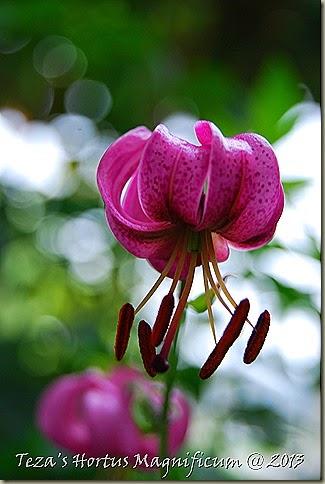
Of the three major species of Galanthus that are grown in most gardens today, Galanthus nilalis is probably the first to have arrived, having been introduced by the Romans. By the Middle Ages white flowers were associated with purity and worshippers brought more Galanthus nivalis to the shores of Great Britain, where, even today, it remains one of the capitals of collecting and hybridizing. Galanthus plicatus arrived in the 1600’s, and there was an influx of this species in the 1850’s, brought back with soldiers returning from the Crimean War. It wasn’t until the 1880’s that Galanthus elwesii was discovered in Turkey. Perhaps the most easily recognizable, it was soon imported into Britain in vast numbers!
During the Victorian Era, they were still looked upon as a symbol of purity: they were used as a solo on mineral water bottles, and there was even a Snowdrop League for Young Ladies. Perhaps because they will thrive without much looking after, they were often planted on graves. ( and in fact nowadays churchyards are a prime venue for galanthophiles who are searching out new snowdrops – in England at least!] By the beginning of the First World War ‘snowdrops’ had become synonymous with sadness and loss, appearing on funereal cards. By the middle of the twentieth century though, their popularity was on the rebound. Today, only the most serious of Galanthophile would ever consider paying in excess of $500 for a single Galanthus ‘Flocon de neige’ – one of the true ‘Holy Grail’ species within the genus!

Galanthus is derived from the Greek words ‘gala’ meaning milk and ‘anthos’ meaning flower. These beguiling flowers bloom when little else is in bloom in the gardens, with the notable exception of Helleborus and Hamamelis. Galanthus is a bulb made up of swollen leaf bases attached to a basal plate. Most bulbs are wrapped in a papery tunic of old dried leaf bases. Galanthus need a moist environment so that they do not ever dry out. Even when it appears that they are dormant, they are busily ‘working’ on next year’s flowers and foliage.
Traditionally each bulb produces one flowering stem, but with the species G. plicatus, there are sometimes two. The flower emerges from the bulb enclosed in a clear skin known as a ‘spathe’, and break through this barrier as they mature. On warm days the outer petals are held open as to appear almost horizontal. This action is provided purely to attract the essential pollinating insects that it relies heavily upon. The glowing markings seem to provide more than a means of identifying the various species and cultivars, attracting bumble and honeybees alike.
The flowers, held at the end of the scape, and attached by a pedicel is made up of three outer, and three inner petals, with the inner ones being approximately half the size of the outer ones. There are also double forms which may have up to twenty inner petals surrounded by four to five outer. Each Galanthus possesses the distinguishing green markings, some single, others a complexity of splotches and dashes.
Galanthus prefer a slightly alkaline soil but most are very accommodating. Most enjoy full sunlight when they are flowering, but prefer a shaded location when ‘sleeping,’ so placement under deciduous trees is ideal, especially for G. nivalis. The division of Galanthus is important to maintain vigor. Many growers divide and sell Galanthus ‘in the green’ just after they have flowered. Some prefer to divide just before they bloom, which is said to increase the reliability of bloom for the following year. Still others believe that division and movement should only occur when the plants are in their ‘dormant’ or sleeping mode. It is essential to plant deeply and mix in plenty of leaf mould and compost.
There are roughly nineteen species of Galanthus, and within that framework, well over five hundred known cultivars. Prices range from less than a dollar to as mentioned earlier, well over five hundred for the rare and hard to find cultivars. Galanthophiles are yet another rare breed of the horticulturally obsessed! Have you started your own collection yet?


































4 comments:
Your photos are lovely. I'm not even sure of the species of my clump since it's been here for so long and I dug it up at the house we lived at before moving here and that was over 10 years ago. Whew! Still I love having it show up every year. I've got a little vaseful right by me. Call me a Galanthophile albeit a fairly ignorant one.
A wee factoid to add to the Galanthus file - apparently the sap contains an anti-freeze which allows them to come up so early.
Well, dearest T, I think you know whose heart you struck with this post. How can I start a collection with no sources in our great country? Perhaps I should take a trip to the UK and smuggle a few back, hmmm.....
Beautiful flower! I really like it....thanks for the posting..
Post a Comment